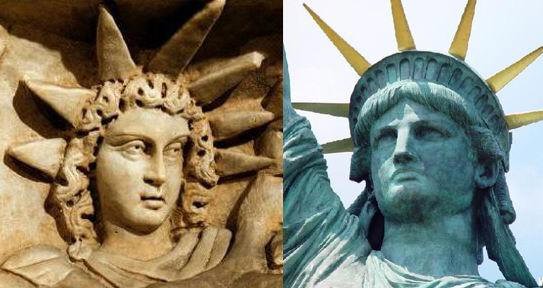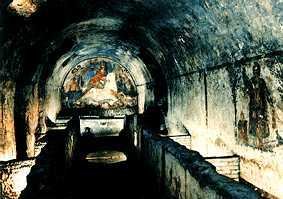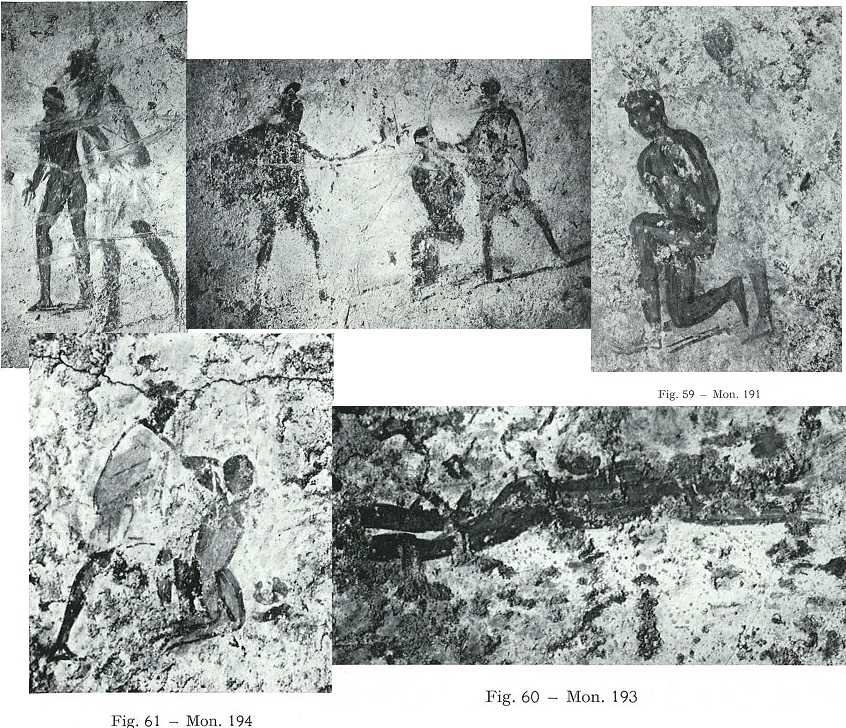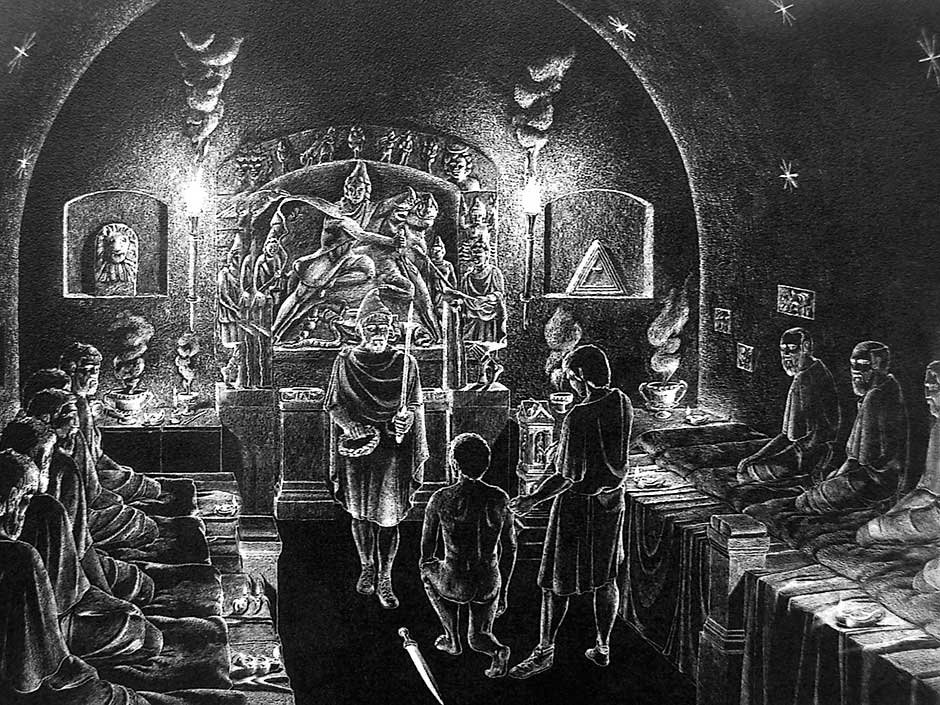
Active in ancient Roman society, the Cult was first recorded around the first century AD, the same time another group was starting its own appearance – Christianity. With a history that goes back 6,000 years or more, Mithras is the ancient Persian god of friendship, contracts, and order . It is thought that when the Roman Empire came into contact with the cultures of the east, specifically Persian Zoroastriansim (Mithra was a minor deity under the main Zoroastra God of Ahura-Mazda), that the ideas of Mithraism were brought back and spread around the Empire. Possibly spread at the start by just one man, said to be the ‘genius’.
The word Mithra is said to mean friend or contract, based off the Sanskrit mitra or Persian mihr meaning friend, the Zend word Mithra meaning contract, and the Latin root mei- meaning exchange. So something like a loyal or binding friendly exchange, a brotherhood. Since only men could join, that’s in essence what they were.

Worshippers of Mithras would meet in caves, or temples built underground – many included a water source. In cities where land was already claimed, an underground room of a local bathhouse or the basement of an apartment might have been converted to a temple of Mithra. These long and narrow rooms were not very large, and most congregations were only between 15-40 people.
In every temple there was a fresco called Mithras and the Bull, or the tauroctony. It depicted Mithras killing a bull inside a cave with a lot of symbolic meanings. A dog and a snake lick the blood. A scorpion stings the testicles (go lil’ buddy). A raven usually sits on the bulls tail that ends in grain and will relay messages from Mithras to the God of the sun, Invictus. Some have two other figures, named Cautes and Cautopates holding torches(one points up one points down), and in the upper right the moon God, Luna.

Another related fresco, sometimes on the reverse of the tauroctony, is called The Banquet of the Sun. In this one it shows Mithras sharing the meat with Invictus, and they eat it over the hide of the slaughtered bull.
You will also find in the temples a God named Arimanius, the lion-headed figure. Said to be the demon God Ahriman from the Zoroastrian religion.

The meaning of all this symbolic art has been lost to time and every region of the world depicted events slightly different, but here is the story as commonly agreed. Mithras was born out of a boulder. Mithras shot an arrow at a rock and water poured forth. Throughout his life he was accompanied by two companions as well as, a dog, a snake, a raven, and a scorpion. Armed with a gladius (short sword), he battled the Sun God. Unable to beat the Sun, he captured a bull and dragged it to a cave where he slaughtered it. He sent the raven to invite the Sun God to a feast, where they ate the meat. Later Mithras died and was buried in a cave, and then was resurrected and entered paradise.
There were seven ranks to achieve for an aspiring Mithratic, each with a related protector God:
CORAX - Raven (Mercury)
NYMPHUS – Male Bride (Venus)
MILES - Soldier (Mars)
LEO - Lion (Jupiter)
PERSES - Persian (Moon)
HELIODROMUS – Sun-Runner (Sun)
PATER - Father (Saturn)
To become a member you had to perform the initiation ritual. Thanks to some drawings that survived in a Mithraeum in Capua, we have some idea of what that entailed. The initiate was stripped naked and blindfolded, he then was brought into the temple and made to kneel while his hands are bound with chicken guts. Then it goes to the initiate being crowned, to he is kneeling with a sword at his throat, and then appears lying dead on the ground.
[I usually try to stick to the known facts, but I am going to try and write my visualization of what would happen during this ritual. This story is based off the drawings and a mix of numerous theories I read while researching this article.]

The initiate has been fasting for three days, held away from the world while he learned the story of Mithras. Preparing to perform the tests of initiation and brainwashed into giving up all ties to anyone not in the cult. Nothing matters anymore but the worship of Mithra. Given some intoxicating substance, he was stripped of his clothes and blindfolded. Two nymphus lead him into the temple amid the sound of chants, drums, and other instruments.
Made to kneel before the Pater (dressed as Mithras), he was asked a series of questions to which he must give the correct answers. If he passed he was given (holy)water from the sacred stream and served bread on a plate of stretched hide, the bread was the body of the Bull. By accepting the offering, the initiate was ready to accept Mithras as his life, swearing an oath to serve Mithras and had a mark drawn on his forehead with the sacred water.
Next the Sun God (a Heliodromus dressed as Invictus) would offer the initiate the kingdom of the Earth. Extending to the man a sword upon which was a crown, the initiate would lean in his head to take the crown and his bindings would be cut. He would then throw the crown to the side and say ‘Mithras is my crown’.
The initiate and Invictus would perform a mock-battle in which the Sun God wins. Invictus would force the man to kneel, and would mock cut his throat (to give your life for Mithras). Falling to the ground, he would lay there dead until the Pater (Mithras) ‘resurrected’ him. Then everyone would feast to welcome a new brother!

The society seemed to be popular among Roman legionnaires which was a major reason it spread to all ends of the Empire. A Mithras temple has even been found in London. Many high ranked Roman citizens were part of the cult and it was supported, at times, by many emperors. This meant that throughout the Roman Empire the worshippers of Mithras were held in high esteem.
The cult enjoyed prosperity from about 100-300 AD, and only ran into trouble after the emperor Constantine converted to Christianity in 313. Not wanted to anger the emperor, many people stopped joining the cult of Mithras. Archaeological evidence suggest many temples were desecrated, probably because of growing Christian fervor as they came into power and destroyed many pagan sites. It didn’t help that Mithraism only allowed men, held small congregations, and were secretive. While the Christians allowed all, had as many people as could fit, and became more and more open about being a Christian as they were accepted.
So the cult of Mithras fell out of favor in the 4th century, but not all their ideas and traditions disappeared. Many other secret societies have been said to have links back to the cult. As a new secret society saying you have history that goes back thousands of years can add an instant gravitas to your words. It can also be said that some of the rituals are similar to Christianity, but if they were adopted from Mithraism or these two religions both took the rituals from Zoroastrianism it can’t be known for sure.
One thing I do know was that Mithraism’s most honored ceremony, the Birth of the Sun, was held every year on December 25th. A celebration the Christians didn’t observe until the 4th century.
